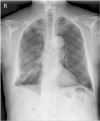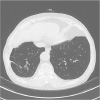1. . Global strategy for the diagnosis, management, and prevention of chronic obstructive pulmonary disease (updated 201). 2014.
2. Becklake M. Occupational exposures: evidence for a causal association with chronic obstructive pulmonary disease. Am Rev Respir Dis. 1989; 140:S85–91. DOI:
10.1164/ajrccm/140.3_Pt_2.S85. PMID:
2675712.
3. Walter R, Gottilieb DJ, O'Connor GT. Environmental and genetic risk factorsand gene-environment interactions in the pathogenesis of chronic obstructive lung disease. Environ Health Prosepect. 2000; 108:733–42. DOI:
10.1289/ehp.00108s4733.
4. Weinmann S, Vollmer WM, Breen V, Heumann M, Hnizdo E, Villnave J, et al. COPD and occupational exposures: a case-control study. J Occup Environ Med. 2008; 50:561–9. DOI:
10.1097/JOM.0b013e3181651556. PMID:
18469625.
5. Balmes JBM, Blanc P, Henneberger P, Kreiss K, Mapp C, Milton D, et al. American Thoracic Society Statement: occupational contribution to the burden of airway disease. Am J Respir Crit Care Med. 2003; 167:787–97. DOI:
10.1164/rccm.167.5.787. PMID:
12598220.
7. Lee HP, Koh DH, Lee EC. Occupational chronic obstructive pulmonary disease cases evaluated by workers' compensation in Korea. Korean J Occup Environ Med. 2009; 21:53–62.
8. MacDonald RD, Thomas L, Rusk FC, Marques SD. Occupational health and saftey assessment of exposure to jet fuel combustion products in air medical transport. Prehosp Emerg Care. 2010; 14:202–8. DOI:
10.3109/10903120903524955. PMID:
20199234.
9. Mehta AJ, Miedinger D, Keidel D, Bettschart R, Bircher A, Bridevaux PO, et al. Occupational exposure to dusts, gases, and fumes and incidence of chronic obstructive pulmonary disease in the Swiss cohort study on air pollution and lung and heart diseases in adults. Am J Repir Crit Care Med. 2012; 185:1292–300. DOI:
10.1164/rccm.201110-1917OC.
10. Trupin LEG, San Pedro M, Balmes JR, Eisner MD, Yelin E, Katz PP, et al. The occupational burden of chronic obstructive pulmonary disease. Eur Respir J. 2003; 22:462–9. DOI:
10.1183/09031936.03.00094203. PMID:
14516136.
11. Blanc PD, Menezes AMB, Plana E, Mannino DM, Hallal PC, Toren K, et al. Occupational exposures and COPD: an ecological analysis of international data. Eur Respir J. 2009; 33:298–304. DOI:
10.1183/09031936.00118808. PMID:
19010980.
12. Bonner JC, Rice AB, Moomaw CR, Morgan DL. Airway fibrosis in rats induced by vanadium pentoxide. Am J Physiol Lung Cell Mol Physiol. 2000; 278:L209–16. PMID:
10645909.
13. Shore S, Kobzik L, Long NC, Skornik W, Van Staden CJ, Boulet L, et al. Increased airway responsiveness to inhaled methacholine in a rat model of chronic bronchitis. Am J Respir Crit Care Med. 1995; 151:1931–8. DOI:
10.1164/ajrccm.151.6.7767542. PMID:
7767542.
14. Wewers MD, Casolaro MA, Sellers SE, Swayze SC, McPhaul KM, Wittes JT, et al. Replacement therapy for Alpha
1-Antitrypsin deficiency associated with Emphysema. N Engl J Med. 1987; 316:1055–62. DOI:
10.1056/NEJM198704233161704. PMID:
3494198.
15. Boschetto P, Quintavalle S, Miotto D, Lo Cascio N, Zeni E, Mapp CE. Chronic obstructive pulmonary disease (COPD) and occupational exposures. J Occup Med Toxicol. 2006; 1:11. DOI:
10.1186/1745-6673-1-11. PMID:
16756686.
16. Finlay GA, O'Driscoll LR, Russell KJ, D'Arcy EM, Masterson JB, FitzGerald MX, et al. Matrix metalloproteinase expression and production by alveolar macrophages in emphysema. Am J Respir Crit Care Med. 1997; 156:240–7. DOI:
10.1164/ajrccm.156.1.9612018. PMID:
9230755.
17. Hautamaki RD, Kobayashi DK, Senior RM, Shapiro SD. Requirement for macrophage elastase for cigarette smoke-induced emphysema in mice. Science. 1997; 277:2002–4. DOI:
10.1126/science.277.5334.2002. PMID:
9302297.
18. Kim HW, Roh YM, Phee YG, Won JI, Kim YW. Analysis of quartz contents by XRD and FTIR in respirable dust from various manufacturing industries part 1 - foundry. J Korean Soc Occup Environ Hyg. 1998; 8:50–66.
19. Phee YG, Roh YM, Lee KM, Kim HA, Kim YW, Won JI, et al. Analysis of quartz content and particle size distribution of airbone dust from selected foundary operations. J Korean Soc Occup Environ Hyg. 1997; 7:196–208.
20. Park YS, Roh YM, Kim HW, Han JG, Ahn YS, Kang SK, et al. A study of respirable dust concentrations and quartz contents in foundry. J Korean Soc Occup Environ Hyg. 2003; 13:90–7.
21. Phee YG, Kim HW. Current status of environmental hazards of iron and steel foundry operations in Korea. J Korean Soc Occup Environ Hyg. 2003; 13:99–106.
22. Burstyn I, Boffetta P, Heederik D, Partanen T, Kromhout H, Svane O, et al. Mortality from obstructive lung diseases and exposure to polycyclic aromatic hydrocarbons among asphalt workers. Am J Epidemiol. 2003; 158:468–78. DOI:
10.1093/aje/kwg180. PMID:
12936902.
23. Park CK, Choi JW, Yeo IH, Yun JS, Kim MY. PAHs source fingerprints for municipal incinerator, motor vehicle fuels and industrial boilers emission. J Korean Soc Atmos Environ. 2004; 20:331–43.
24. Torén K, Järvholm B. Effect of occuoational exposure to vapors, gases, dusts, and fumes on COPD mortality risk among Swedish construction workers: a longditudinal cohort study. Chest. 2014; 145:992–7. DOI:
10.1378/chest.13-1429. PMID:
24264472.
25. Halbert RJ, Isonaka S, George D, Iqbal A. Interpreting COPD prevalence estimates: what is the true burden of disease? Chest. 2003; 123:1684–92. DOI:
10.1378/chest.123.5.1684. PMID:
12740290.
26. Von deurssen E, Pronk A, Spaan S, Goede H, Tielemans E, Heederik D, et al. Quartz and respirable dust in the Dutch construction industry: a baseline exposure assessment as part of a multidimensional intervention approach. Ann Occup Hyg. 2014; in press.
27. Jaen A, Zock JP, Kogevinas M, Ferrer A, Marin A. Occupation, smoking, and chronic obstructive respiratory disorders: a cross sectional study in an industrial area of Catalonia, Spain. Environ Health. 2006; 5:2. DOI:
10.1186/1476-069X-5-2. PMID:
16476167.
28. Blanc PD, Iribarren C, Trupin L, Earnest G, Katz PP, Balmes J, et al. Occupational exposures and the risk of COPD: dustytrades revisited. Thorax. 2009; 64:6–12. DOI:
10.1136/thx.2008.099390. PMID:
18678700.
29. Boggia B, Farinaro E, Grieco L, Lucariello A, Carbone U. Burden of smoking and occupational exposure on etiology of chronic obstructive pulmonary disease in workers of Southern Italy. J Occup Environ Med. 2008; 50:366–70. DOI:
10.1097/JOM.0b013e318162f601. PMID:
18332787.
30. Fletcher C, Peto R. The natural history of chronic airflow obstruction. Br Med J. 1977; 1:1645–8. DOI:
10.1136/bmj.1.6077.1645. PMID:
871704.






 PDF
PDF Citation
Citation Print
Print



 XML Download
XML Download